Aberdeen, Scotland, UK 作者: 来源: 发布时间:2021-07-29
I. Population and Area
Continent: Europe
Country: The U.K
State/Province: Scotland
City/Town: Aberdeen
Total Area: 71.7 (sq mi)
Population in 2011: 207.9 (thousand)
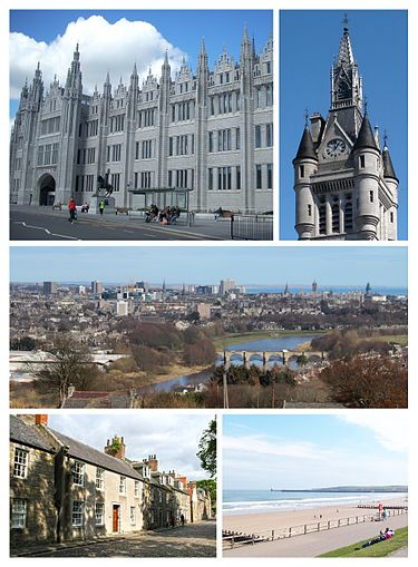
II. Natural Geography (environment and resources)
Geography
Being sited between two river mouths, the city has little natural exposure of bedrock. This leaves local geologists in a slight quandary: despite the high concentration of geoscientists in the area (courtesy of the oil industry), there is only a vague understanding of what underlies the city. To the south side of the city, coastal cliffs expose high-grade metamorphic rocks of the Grampian Group; to the southwest and west are extensive granites intruded into similar high-grade schists; to the north the metamorphics are intruded by gabbroic complexes instead.
The small amount of geophysics done, and occasional building-related exposures, combined with small exposures in the banks of the River Don, suggest that it is actually sited on an inlier of Devonian "Old Red" sandstones and silts. The outskirts of the city spread beyond the (inferred) limits of the outlier onto the surrounding metamorphic/ igneous complexes formed during the Dalradian period (approximately 480–600 million years ago) with sporadic areas of igneous Diorite granites to be found, such as that at the Rubislaw quarry which was used to build much of the Victorian parts of the city.
On the coast, Aberdeen has a long sand beach between the two rivers, the Dee and the Don, which turns into high sand dunes north of the Don stretching as far as Fraserburgh; to the south of the Dee are steep rocky cliff faces with only minor pebble and shingle beaches in deep inlets. A number of granite outcrops along the south coast have been quarried in the past, making for spectacular scenery and good rock-climbing.
The city extends to 185.7 km2 (71.7 sq mi), and includes the former burghs of Old Aberdeen, New Aberdeen, Woodside and the Royal Burgh of Torry to the south of River Dee. In 2017 this gave the city a population density of 1,225.The city is built on many hills, with the original beginnings of the city growing from Castle Hill, St. Catherine's Hill and Windmill Hill.
Transport
Aberdeen Airport (ABZ), at Dyce in the north of the city, serves domestic and international destinations including France, Germany, the Netherlands, Spain, Belgium, Austria, Ireland and Scandinavian countries. The heliport which serves the oil industry and rescue services is one of the world's busiest commercial heliports.
Aberdeen railway station is on the main UK rail network and Abellio ScotRail has frequent direct trains to major cities Edinburgh, Glasgow and Inverness. London North Eastern Railway and the Caledonian Sleeper operate direct trains to London. In 2007 additions were made and a new ticket office was built in the building. The UK's longest direct rail journey runs from Aberdeen to Penzance. It is operated by CrossCountry, leaving Aberdeen at 08:20 and taking 13 hours and 23 minutes. Today, all railway services to the south run via Dundee. The faster main line from Aberdeen to Perth via Forfar and Strathmore closed in 1967 as a result of the Beeching cuts, and the faster main line from Perth to Edinburgh via Glenfarg also subsequently closed in 1970.
Until 2007, a 1950s-style concrete bus station at Guild Street served out-of-the-city locations; it has since transferred to a new and well-presented bus station just 100 metres to the east off Market Street as part of the Union Square development.
There are six major roads in and out of the city. The A90 is the main arterial route into the city from the north and south, linking Aberdeen to Edinburgh, Dundee, Brechin and Perth in the south and Ellon, Peterhead and Fraserburgh in the north. The A96 links Elgin and Inverness and the north west. The A93 is the main route to the west, heading towards Royal Deeside and the Cairngorms. After Braemar, it turns south, providing an alternative tourist route to Perth. The A944 also heads west, through Westhill and on to Alford. The A92 was the original southerly road to Aberdeen prior to the building of the A90, and is now used as a tourist route, connecting the towns of Montrose and Arbroath and on the east coast. The A947 exits the city at Dyce and goes on to Newmachar, Oldmeldrum and Turriff finally ending at Banff and Macduff.
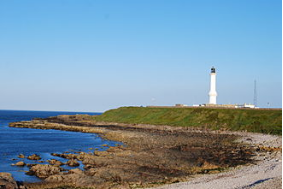
III. Economy
Employment
Aberdeen City and Shire has a higher level of production jobs and lower level of service jobs than the scottish average.
Unemployment figures (January 2015)
City of Aberdeen 1.0%
Aberdeenshire 0.7%
Scotland 2.4%
Average gross weekly earnings (2014)
City of Aberdeen £763.10
Aberdeenshire £681.10
Scotland £600.00
(Source: Office for National Statistics 2015)
Gross Domestic Product
Aberdeen City and Shire £12.34 billion
City of Aberdeen £8.34 billion
Aberdeenshire £3.70 billion
Gross Domestic Product
Aberdeen City and Shire £12.34 billion
City of Aberdeen £8.34 billion
Aberdeenshire £3.70 billion
With less than one-tenth of the population Aberdeen City and Shire accounts for more than 26% of Scotland's private sector turnover. The City of Aberdeen’s combined turnover is just under £55 billion, more than 21% of Scotland's total of £257.5 billion. Source: Office for National Statistics 2011 Aberdeenshire's turnover of just under £12.5 billion represents 4.9% of the Scottish total. Source: Office for National Statistics 2011 The business birth rate in Aberdeen City and Shire increased by 35% from 2005-2012, compared to 3% across Scotland.
Reference Website:
https://www.aberdeen-info.co.uk/facts.html#.X48ChRLitPY
IV. Industrial Characterisitics
Major industries:
Aberdeen, city and historic royal burgh (town) astride the Rivers Dee and Don on Scotland’s North Sea coast. Aberdeen is a busy seaport, the British centre of the North Sea oil industry, and the commercial capital of northeastern Scotland. Aberdeen’s primary industries were once fishing, textiles, shipbuilding, and papermaking. Today its economy is focused on the oil industry, though it has grown more diversified to include electronics design and renewable energy resources.
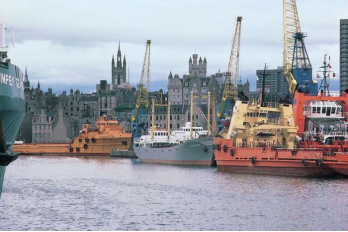
Aberdeen city constitutes an independent council area that covers the burgh of Aberdeen and the surrounding countryside. Most of the city, including the historic centres of Old Aberdeen and New Aberdeen, lies in the historic county of Aberdeenshire, but the city also includes a small area in the south that belongs to the historic county of Kincardineshire. Aberdeen is the historic county town (seat) of Aberdeenshire.
Major projects and related introductions:
IMPORTANT UPCOMING PROJECTS AND DEVELOPMENTS IN ABERDEEN
These are changing times for Aberdeen. The Granite City is right now in the midst of a 25 year regeneration scheme, bringing with it new jobs and investment. Dubbed the City Centre Masterplan, it features a total of 50 projects, including new housing and better access to local amenities.
Late 2017 saw the completion of Marischal Square: a mixed-use development in Broad Street combining office and retail space. Meanwhile, work is underway on the North East 250 road, which will serve the important purpose of increasing the number of visitors to Aberdeen.
For all the issues that Aberdeen’s experienced as a result of the oil industry, the future looks bright. Here are five new projects and developments on the way for Aberdeen:
Reference Website:
https://www.silverdoorapartments.com/blog/important-upcoming-projects-and-developments-in-aberdeen/
https://www.britannica.com/place/Aberdeen-Scotland
V. Attractions
1. St. Machar's Cathedral:
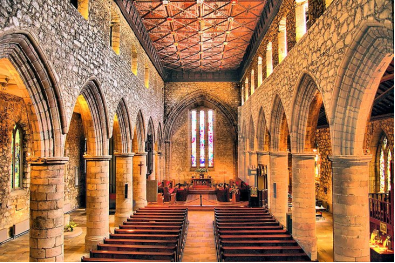
The Cathedral Church of St. Machar — usually referred to simply as St. Machar's Cathedral — is believed to occupy the site of a small Celtic chapel erected by St. Machar in AD 581. The succeeding cathedral was founded in 1136, although the earliest work in the present building dates from the 14th century (it was completed in 1552).
Of particular note to visitors are the striking towers on the West front, with their sandstone spires dating from 1518 to 1530, and the 16th-century wooden ceiling painted with coats of arms. Be sure to also pay attention to the stained-glass windows, most dating from the 1870s.
If you can, try to time your visit to coincide with one of the frequent classical or choral concerts held here (details are available on the cathedral website below). A shop is located on-site.
2. The University and King's College of Aberdeen:
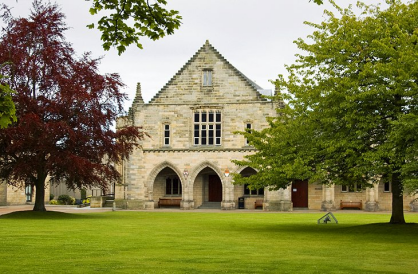
Founded in 1494 in what's known as Old Aberdeen, the University and King's College of Aberdeen received its charter from King James IV. One of the college's identifying features is its huge tower (1633) and an elegant stone dome, the only remaining structure of its kind in Scotland and notable for the stone replica of the imperial crown of Charlemagne that sits atop it. The 16th-century oak choir stalls and wooden ceiling in the chapel are preserved in their original form, and portraits of the Stuart monarchs are carved in wood.
The University of Aberdeen Zoology Museum is rated one of the top free things to do in the city and covers everything from protozoa to whales. Also of interest is the King's Museum, which features temporary exhibits of artifacts from various university collections. Self-guided walking tours of the university are available from its website.
3. Brig o'Balgownie: Scotland's Oldest Bridge:
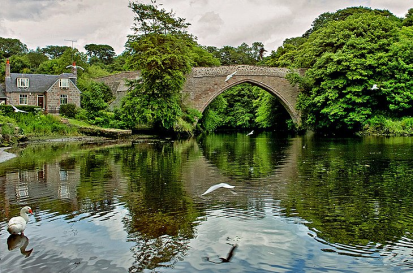
Aberdeen is home to one of Scotland's most romantic settings: the Brig o'Balgownie. Also known as the Bridge of Don, you can access this attractive stone structure via a short walk through Seaton Park. Built on the orders of Robert the Bruce around 1320 and restored in 1607, it served as the River Don's main crossing point. Lord Byron, who went to school in Aberdeen for a short time, referred affectionately to the single span bridge in his satirical poem, Don Juan.
Another fine old bridge is Brig o'Dee. Dating from the 1520s, it's decorated with interesting coats-of-arms and inscriptions and is set in lovely Duthie Park, famous for having one of the largest winter gardens in the world.
Reference Website:
https://www.planetware.com/tourist-attractions-/aberdeen-sco-grm-aber.htm
VI. History
The Aberdeen area has seen human settlement for at least 8,000 years. The city began as two separate burghs: Old Aberdeen at the mouth of the river Don; and New Aberdeen, a fishing and trading settlement, where the Denburn waterway entered the river Dee estuary The earliest charter was granted by William the Lion in 1179 and confirmed the corporate rights granted by David I.
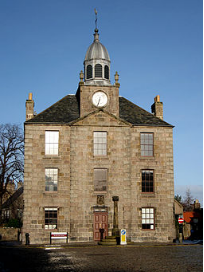
In 1319, the Great Charter of Robert the Bruce transformed Aberdeen into a property-owning and financially independent community. Granted with it was the nearby Forest of Stocket, whose income formed the basis for the city's Common Good Fund which still benefits Aberdonians.
During the Wars of Scottish Independence, Aberdeen was under English rule, so Robert the Bruce laid siege to Aberdeen Castle before destroying it in 1308, followed by executing the English garrison. The city was burned by Edward III of England in 1336, but was rebuilt and extended. The city was strongly fortified to prevent attacks by neighbouring lords, but the gates were removed by 1770.
During the Wars of the Three Kingdoms of 1644 to 1647 the city was plundered by both sides. In 1644, it was taken and ransacked by Royalist troops after the Battle of Aberdeen and two years later it was stormed by a Royalist force under the command of the Marquis of Huntly. In 1647 an outbreak of bubonic plague killed a quarter of the population. In the 18th century, a new Town Hall was built and the first social services appeared with the Infirmary at Woolmanhill in 1742 and the Lunatic Asylum in 1779. The council began major road improvements at the end of the 18th century with the main thoroughfares of George Street, King Street and Union Street all completed at the beginning of the 19th century.
Over the course of the Second World War Aberdeen was attacked 32 times by the German Luftwaffe. One of the most devastating attacks was on Wednesday 21 April 1943 when 29 Luftwaffe Dornier 217s flying from Stavanger, Norway attacked the city between the hours of 22:17 and 23:04. A total of 98 civilians and 27 servicemen were killed, along with 9,668 houses damaged, after a mixture of 127 Incendiary, High Explosive and Cluster bombs were dropped on the city in one night. It was also the last German raid on a Scottish city during the war.
VII. Culture
Museums and galleries
The city has a wide range of cultural activities, amenities and museums.The city is regularly visited by Scotland's National Arts Companies. The Aberdeen Art Gallery houses a collection of Impressionist, Victorian, Scottish and 20th-century British paintings as well as collections of silver and glass. It also includes The Alexander Macdonald Bequest, a collection of late 19th-century works donated by the museum's first benefactor and a constantly changing collection of contemporary work and regular visiting exhibitions.
Festivals and performing arts
Aberdeen is home to a number of events and festivals including the Aberdeen International Youth Festival (the world's largest arts festival for young performers), Aberdeen Jazz Festival, Aberdeen Alternative Festival, Rootin' Aboot (a folk and roots music event), Triptych, the University of Aberdeen's literature festival Word and DanceLive, Scotland's only Festival of contemporary dance, which is produced by the city's Citymoves dance organisation. The Aberdeen Student Show, performed annually without interruption since 1921, under the auspices of the Aberdeen Students' Charities Campaign, is the longest-running of its kind in the United Kingdom. It is written, produced and performed by students and graduates of Aberdeen's universities and higher education institutions. Since 1929—other than on a handful of occasions—it has been staged at His Majesty's Theatre. The Student Show traditionally combines comedy and music, inspired by the North-East's Doric dialect and humour.
Music and film
Aberdeen's music scene includes a variety of live music venues including pubs, clubs, and church choirs. The bars of Belmont Street are particularly known for featuring live music. Ceilidhs are also common in the city's halls. Popular music venues include the Aberdeen Exhibition and Conference Centre (AECC), Aberdeen Music Hall, along with smaller venues such as The Tunnels, The Moorings, Drummonds, Downstairs, The Lemon Tree and The Garage. Notable Aberdonian musicians include Annie Lennox, Emeli Sandé, cult band Pallas and contemporary composer John McLeod. There are many local bands including Grader, Sleepless, Hayworth, Deceptions, Without Reason, Monroe and Deadfire. A large proportion of Aberdeen's classical music scene is based around the ensembles of Aberdeen University's music department, notably the Symphony Orchestra, Marischal Chamber Orchestra, and the Concert Band.
VIII. Other information
Universities and colleges
Aberdeen has two universities, the ancient University of Aberdeen, and Robert Gordon University, a modern university often referred to as RGU. Aberdeen's student rate of 11.5% is higher than the national average of 7%.
The University of Aberdeen began as King's College, Aberdeen, which was founded in 1495 by William Elphinstone (1431–1514), Bishop of Aberdeen and Chancellor of Scotland. Marischal College, a separate institution, was founded in "New" Aberdeen by George Keith, fifth Earl Marischal of Scotland in 1593. These institutions were merged by order of Parliament in 1860 to form the University of Aberdeen. The university is the fifth oldest in the English-speaking world and offers degrees in a full range of disciplines. Its main campus is in Old Aberdeen in the north of the city and it currently has approximately 14,000 students. The university's debating society is the oldest in Scotland, founded in 1848 as the King's College Debating Society. Today, Aberdeen is consistently ranked among the top 200 universities in the world and is ranked within the top 30 universities in the United Kingdom. Aberdeen was also named the 2019 Scottish University of the Year by The Times and Sunday Times Good University Guide.
Schools
here are currently 12 secondary schools and 54 primary schools which are run by the city council. The most notable are Aberdeen Grammar School (founded in 1257), Harlaw Academy, Cults Academy, and Oldmachar Academy which were all rated in the top 50 Scottish secondary schools league tables published by The Times in 2005. Harlaw Academy was taken down from the list after a short time but is still a popular school. There are a number of private schools in Aberdeen: Robert Gordon's College, Albyn School for Girls (co-educational as of 2005), St Margaret's School for Girls, the Hamilton School (closed by the Child Care Inspectorate in early 2014), the Total French School (for French oil industry families), the International School of Aberdeen and a Waldorf/Steiner School.
Primary schools in Aberdeen include Airyhall Primary School, Albyn School, Ashley Road Primary School, Balgownie Primary School, Broomhill Primary School, Cornhill Primary School (the city's largest), Culter Primary School, Cults Primary School, Danestone Primary School, Fernielea Primary school, Ferryhill Primary School, Gilcomstoun Primary School, Glashieburn Primary School, Greenbrae School, Hamilton School, Kaimhill Primary School, Kingsford Primary School, Kittybrewster Primary School, Middleton Park Primary School, Mile-End School, Muirfield Primary School, Robert Gordon's College, Skene Square Primary School, St. Joseph's Primary School and St Margaret's School for Girls.
IX. Contact information
Mayor/Officer: Barney Crockett
Tel: 01224 522514
Mail: bcrockett@aberdeencity.gov.uk
Reference Website:
https://committees.aberdeencity.gov.uk/mgUserInfo.aspx?UID=133
